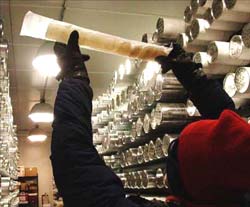Ozone-destroying gas in atmosphere increased significantly during Industrial Age, study shows

Photograph by: Melanie Conner, National Science Foundation <br>
By examining trapped air bubbles in an ice core, researchers extend atmospheric record of methyl bromide over 300 years
Human activity in the Industrial Age – approximately the last 150 years – has significantly increased atmospheric levels of methyl bromide, a gas known for harming the ozone layer in the Earth’s stratosphere.
A research team led by UC Irvine scientist Eric Saltzman reached this conclusion after examining an ice core recovered from Antarctica. By studying air bubbles trapped in the core, Saltzman’s team was able to compare levels of methyl bromide in the atmosphere over the last three centuries. The team concluded that during the industrial era, the amount of global atmospheric methyl bromide in Southern Hemisphere air appears to have increased by 3.5 parts per trillion, or approximately 50 percent of the preindustrial level of the gas.
The researchers report their findings in the March 2, 2004, issue of the Journal of Geophysical Research – Atmospheres.
In the study, the researchers utilized 23 samples of shallow ice core drilled in 1995 in Siple Dome, West Antarctica, as part of a National Science Foundation-sponsored ice coring project in the West Antarctic ice sheet. Air was extracted from the samples in Saltzman’s laboratory at UCI and analyzed using gas chromatography/mass spectrometry, a powerful analytical technique.
“We found trace levels of methyl bromide dating back to the late 1600s in the core’s air bubbles,” said Saltzman, professor of Earth system science. “This longer-term record of methyl bromide shows convincingly that the amount of methyl bromide in the atmosphere increased during the industrial era. The reconstruction of ancient atmospheric levels of methyl bromide is an exciting development. Ice core records can provide insights into the natural variability of methyl bromide and shed light on how sensitive its atmospheric cycle is to climate change.”
Previous records of methyl bromide in the atmosphere – a compilation of instrumental records and firn air measurements – had only extended back to about the year 1900. (Firn is rounded, well-bonded snow that is older than one year.)
The researchers also developed a numerical model to simulate major processes involved in the global biogeochemical cycle of methyl bromide. Both the ice core measurements and modeling results show that human activities such as fumigation, combustion and biomass burning in industrial times have significantly increased atmospheric levels of this gas. “They also highlight the large uncertainty still remaining in our understanding of the modern atmospheric methyl bromide budget,” Saltzman said.
Methyl bromide is a fumigant used to control insects, nematodes, weeds and pathogens in crops, forests and wood products. Its primary uses are for soil fumigation, postharvest protection and quarantine treatments. The gas also has natural sources in both terrestrial and oceanic environments, as well as natural “sinks” that can remove methyl bromide from the atmosphere. It is the only chemical included in the Montreal Protocol – the international agreement designed to protect the Earth’s stratospheric ozone layer – that has major natural sources. Understanding the natural sources and sinks of methyl bromide is a focus of current research, as is gaining a greater understanding of other gases harming the ozone layer, which protects the Earth from ultraviolet radiation.
Researchers Murat Aydin of UCI; Warren J. De Bruyn of Chapman University, Orange, Calif.; Daniel B. King of Drexel University, Philadelphia, Pa.; and Shari A. Yvon-Lewis of the National Oceanic and Atmospheric Administration, Miami, Fla., also contributed to the study. The research was supported by the National Science Foundation and the National Oceanic and Atmospheric Administration.
Media Contact
More Information:
http://today.uci.edu/news/release_detail.asp?key=1113All latest news from the category: Earth Sciences
Earth Sciences (also referred to as Geosciences), which deals with basic issues surrounding our planet, plays a vital role in the area of energy and raw materials supply.
Earth Sciences comprises subjects such as geology, geography, geological informatics, paleontology, mineralogy, petrography, crystallography, geophysics, geodesy, glaciology, cartography, photogrammetry, meteorology and seismology, early-warning systems, earthquake research and polar research.
Newest articles

You are What You Eat—Stanford Study Links Fiber to Anti-Cancer Gene Modulation
The Fiber Gap: A Growing Concern in American Diets Fiber is well known to be an important part of a healthy diet, yet less than 10% of Americans eat the minimum recommended…

Trust Your Gut—RNA-Protein Discovery for Better Immunity
HIRI researchers uncover control mechanisms of polysaccharide utilization in Bacteroides thetaiotaomicron. Researchers at the Helmholtz Institute for RNA-based Infection Research (HIRI) and the Julius-Maximilians-Universität (JMU) in Würzburg have identified a…

ASXL1 Mutation: The Hidden Trigger Behind Blood Cancers and Inflammation
Scientists show how a mutated gene harms red and white blood cells. LA JOLLA, CA—Scientists at La Jolla Institute for Immunology (LJI) have discovered how a mutated gene kicks off…



